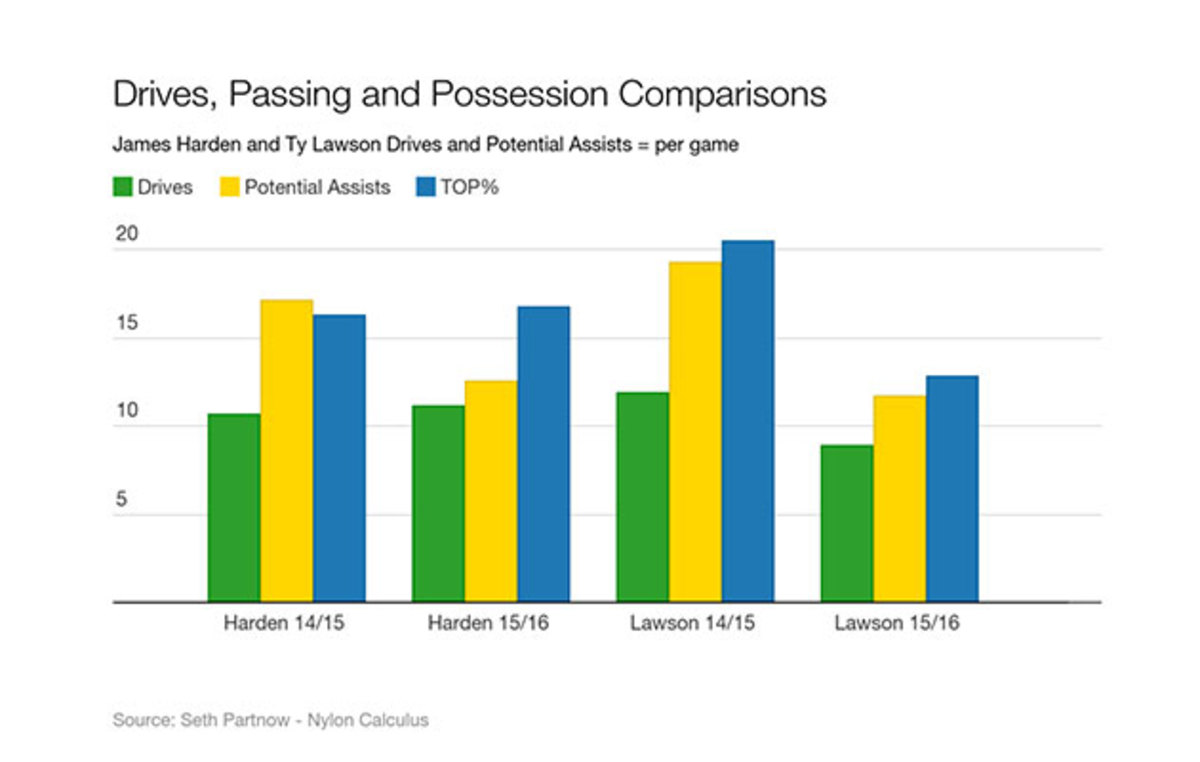Numbers behind Harden's struggles: What's plaguing the Rockets' star?

Without a doubt, the two biggest disappointments in the NBA on the young season are the New Orleans Pelicans and Houston Rockets. While the Pelicans' woes are at least understandable, given the team’s combination of no depth and key injuries, the Rockets are a bit more mystifying. Many (whoops!) were extremely optimistic on their chances before the season due to the team's depth and prospective ability to play multiple different styles. Needless to say, it hasn’t worked out that way so far.
On Wednesday, the Rockets fired their head coach Kevin McHale after a 4-7 start. That decision might seem abrupt for a team that made the Western Conference finals last season, but the first 11 games have been troubling for a team that was expected to be a contender. Most worrisome of all might be the struggles of the team's star: James Harden.
• Nylon Calculus: Exploring the NBA via analytics, research and storytelling
So what’s going on with Harden? Focusing purely on production and not delving into the realm of off-court rumor and innuendo, how has his game changed from last year to this season?
The All-Anomaly Team: NBA outliers pulling off strange statistical feats
Defensively, Harden appears to have regressed towards the indifference which made him so meme-worthy (for all the wrong reasons) during the 2013-14 season.
On the offensive end, the differences are slightly harder to spot. He’s doing all the same things, only far less effectively. “Doing all the same things” might actually be part of the problem. The acquisition of Ty Lawson was supposed to allow Harden to switch things up a bit, allowing him to play off the ball, get some easier catch-and-shoot looks and attack closeouts rather than having to beat walls of defenders one-on-one.
Instead, Lawson has been reduced to a similar “dribble it up, now go stand in the corner” role to the one played by Patrick Beverley. But unlike Beverley, Lawson has long been a dynamic penetrator and playmaker. He led the NBA in both drives (11.9 per game) and potential assists (19.3) per game last season. Harden ranked highly in both—No. 5 in drives at 10.7 and No. 9 in potential assists at 17.1 per game respectively. Sharing the ball would likely result in drop offs to some degree for both players. But it hasn’t:

Lawson’s ball-handling role has declined significantly, while Harden’s has stayed relatively constant. The one difference is Harden is creating far fewer shots for his teammates this year than last.
This drop in effectiveness can be seen looking into the detail of Harden’s drives as well. He is shooting a similar percentage on drives as he did last year, and is actually getting fouled almost 50% more often. But the playmaking aspect of his forays to the paint have largely vanished. In 2014-15 Harden an assist-to-turnover ratio of 1.9:1 on drives. This season, those numbers have essentially reversed, with 15 turnovers against only 7 assists.
NBA Power Rankings: Warriors, Cavs remain on top; Heat shoot up to No. 4
To some degree this is simply a case of Harden playing poorly. However, he does seem to lack the burst which usually makes him such a tough cover off the dribble. Perhaps the increased foul drawing is a result of Harden not being able to create clean separation as much. Watching some of last year’s highlights in comparison, it's hard to remember many plays from this season where Harden undressed his defender with a series a quick dribble moves and an explosive first step.
Certainly, his jump shot has often looked like a player operating without the normal amount of lift. After hitting 40.5% of his catch-and-shoot three-pointers last year, Harden is down to 35.7% this year, essentially the same mark he hit on pull-up threes last year. On those same off-the-dribble attempts, Harden is a putrid 12-of-61 (19.7%!) from beyond the arc.
Perhaps the most telling stat regarding Harden possibly not having his legs under him is that he has only one dunk on the season. While not a player known for detonating finishes at the rim, over the course of his career Harden has managed to throw one down every three to four games on average.
Carrying the offensive workload he does, if Harden showed signs of fatigue in March it would be understandable. No player used more possessions combined shooting and playmaking for teammates than the 3,256 Harden totaled last year. But the season is barely three weeks old, so cumulative fatigue is either not the explanation or a worrying indicator of a much larger problem.
The season is still young. Barring injuries a team can’t really lose their shot at a title in November, but for Houston to have a chance to make any noise at all, they will need Harden to his All-Star level play even if he does not quite reach last year’s MVP-caliber heights.
Seth Partnow is the managing editor of Nylon Calculus. You can read more stories by Seth and the Nylon Calculus team here.
